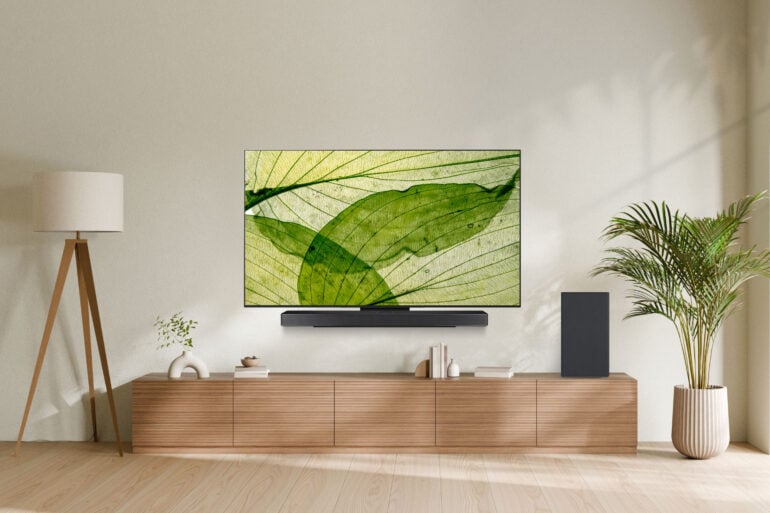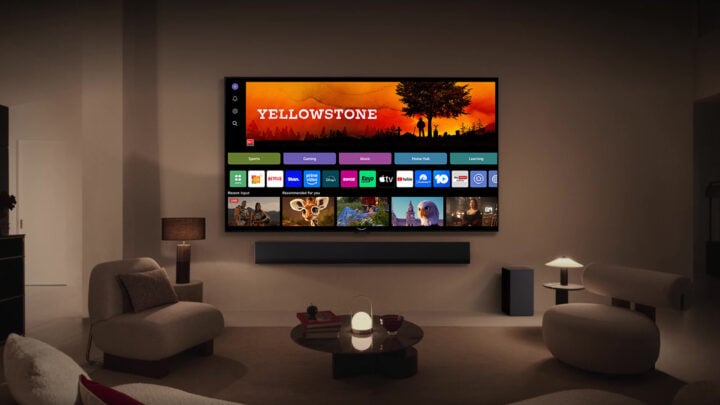
AI this and AI that; so many big tech brands claim to have “AI-powered” appliances. Since generative AI entered the scene, riding the coattails of ChatGPT’s immense popularity, it’s almost impossible to decipher what AI does and doesn’t do.
TVs, however, have employed some form of AI technology since well before the current wave of hype. Look at any TV listed in your local tech store’s catalogue and you’ll see bold claims of improving picture and audio quality, among countless other things.
But what does AI technology in TVs actually do? This year has seen a noticeable shift from just focusing on quality improvements to content recommendations and personalising how your devices operate.
But the main goal has remained steady: to make watching TV look and sound as good as possible.
Optimising TV
Tony Brown, LG’s local Head of Home Entertainment Content and Marketing, believes that TV users only use their devices to a fraction of their full potential.

“Most people would get their TV out of their box, turn it on, set it up and just go, ‘I’m really happy, God knows where the brightness, colour, saturation, contrast stuff is’,” Brown said.
Automating the setup process is LG’s main answer to people intimidated by wading through menus. AI Picture Wizard and the new AI Sound Wizard are ways that avoid tinkering with individual settings.
Both present a series of visual and audio examples to gauge your preferences, before combining them into a setting personalised to your tastes. These settings are also saved to each person’s profile. Logging in then automatically loads a user’s preferred image and sound settings.
For years, TVs have used algorithms and AI processing to upscale lower-resolution content to match the display’s resolution. Modern algorithms and powerful processors identify the contents of each image, and then attempt to make it look as clear as possible while retaining the creator’s original intent.
However, many modern streaming services, like Netflix, use digital rights management (DRM) technology, which complicates matters. Designed to prevent piracy and unauthorised screenshotting, DRM also interferes with TV upscaling efforts.
Older TVs weren’t powerful enough to deal with this, but the latest crop analyses pictures in real-time more efficiently. According to Brown, the stronger processors “instantly recognise the source image, even on streaming or over-the-top services.”
At last, annual TV software upgrades
Stronger processors also mean one thing users have requested for years: annual operating system updates. Last year, LG launched webOS Re:New, an annual software update program that guarantees up to five years of major operating system upgrades.
Akin to the approach taken by phone brands, it means that buying a TV now means you don’t miss out on a new software feature in a year or two’s time. TV owners can access additional features like Xbox cloud streaming and Chromecast without needing to buy a completely new TV set.

But why did it take so long for TVs to get the promise of annual operating system updates? Even LG’s local team asked HQ’s engineering team to get an answer.
Processing power and memory were the primary limitations. Several years ago, LG’s engineers weren’t confident enough to predict that hardware then could be guaranteed to run software features in five years’ time. Now, they’re comfortable that modern TV processors and increased memory allocations are well-equipped to take on whatever the software division’s future plans might bring.
AI: an acronym with many meanings
If you ask TV makers, AI technology isn’t meant to show people what the company thinks they should see. Instead, it’s about showing what big data suggests people want to see at any given moment.
“We want to use AI not to control things, not to take over the world, not to tell you what you should be doing, but to actually assist you in your daily life,” Brown said.
Streamlining TV settings is one thing, but Brown says it’s also about helping people find what they’re looking for quicker. It’s part of what LG calls “Affectionate Intelligence”, the brand’s label applied to using AI across its devices.
He also said that LG’s new TV chatbot is meant to help provide support for commonly asked questions. A TV chatbot may sound like a quaint idea, but LG isn’t the only one with generative AI on the mind — Samsung also integrates Microsoft Copilot into its TVs.
Chatbots may be the flavour of the month, but what’s most interesting is the data powering LG’s specific blend of AI. Big data drives its approach to support and content recommendation, aggregating anonymised data from users globally to identify the most commonly asked queries, and therefore the best-fitting response.
Brown added that LG’s chatbot is built on “hundreds and thousands” of customer support queries, like “I can’t connect my TV to the internet”. When presented with such a question, the chatbot directs users to the specific location of the Wi-Fi settings, again bypassing the process of navigating through various sub-menus.
Based on our recent review of the LG C5 OLED TV, the AI upscaling features are impressive, although the chatbot functionality struggles with Aussie accents.
What about data and user choice?
With any discussion of AI technology, the topics of privacy and data security soon follow. Brown stressed that complying with Australian laws and regulations is the first port of call.
Two additional factors came up when asking about user data: anonymising individual data, and making AI and personalisation features opt-in.
“We’re really not interested in individual users, we’re interested in common themes and giving you an option to personalise,” Brown said. “But equally if you don’t create [a] profile, you’ll still be able to watch TV and use your apps, you just won’t get as much useful stuff served to you.”
“So, it really is we believe in choice.”
The post LG wants its TV AI to assist, not “take over the world” appeared first on GadgetGuy.



0 (mga) komento:
Mag-post ng isang Komento